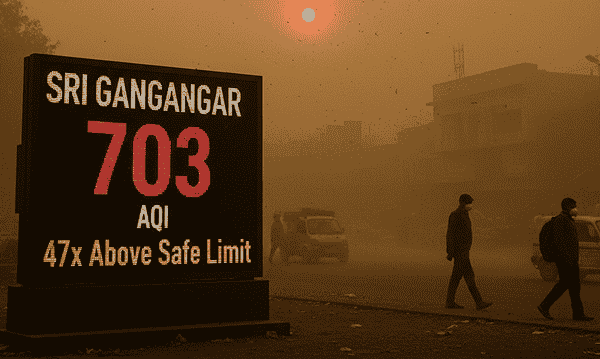India’s Air Crisis has reached alarming new heights, pushing the nation once again to the top of global pollution charts, and not for the right reasons. According to AQI data recorded on 11th November, 11 a.m., all ten of the world’s most polluted cities are in India. Leading the list is Sri Ganganagar, Rajasthan, with a staggering Air Quality Index (AQI) of 703, nearly 47 times higher than the WHO’s safe standard value of 50.
Following close behind are Abohar, Bulandshahr, Nagli Bahrampur, Gurugram, Greater Noida, Ghaziabad, Siwani, and New Delhi, all marked “hazardous.” When business hubs like Gurugram and Noida appear alongside smaller industrial towns, it’s clear that this is not just a local concern anymore. It is a national health emergency.

What’s Behind the Numbers
The toxic haze covering North India is not the result of a single cause. It is the accumulation of several overlapping factors that together fuel India’s Air Crisis.
In agricultural regions such as Sri Ganganagar and Abohar, stubble burning after harvest remains a major contributor. The smoke lingers in the cold air and travels across states, blanketing entire regions.
In industrial zones like Bulandshahr and Ghaziabad, unchecked factory emissions, brick kilns, and open waste burning add heavily to the pollution load.
Urban centers including Delhi, Gurugram, and Greater Noida battle a mix of vehicular emissions, construction dust, and diesel generator fumes. Even smaller towns like Siwani and Nagli Bahrampur worsen the situation through biomass burning and poorly monitored industrial activity.
Different sources, one outcome: an air that grows more unbreathable with each passing day.
Why Winter Makes It Worse
Every winter, India’s air quality drops sharply, and that is not a coincidence.
Cold air traps pollutants closer to the ground through a process called temperature inversion, while low wind speeds prevent their dispersion. Humidity binds the particles together, making the haze appear even thicker.
Add to that the seasonal spike in stubble burning, wood and coal use for heating, and construction dust from ongoing urban projects, and the result is an atmospheric lockdown.
The smog we see every winter is not just a seasonal phenomenon. It is the visible side of our year-round neglect.
Why Policies Don’t Seem to Work
India does not lack pollution-control policies. What it lacks is consistent implementation.
The National Clean Air Programme (NCAP), launched in 2019, aims to cut particulate pollution by 40% by 2026, but progress remains slow because of weak enforcement and fragmented governance. Multiple authorities handle air quality but rarely coordinate with one another.
Short-term bans on firecrackers or construction dust provide temporary relief, while long-term industrial emissions continue unchecked.
Public complacency adds to the problem. People have adapted to living with bad air by sealing windows, buying purifiers, and checking AQI apps instead of demanding systemic change.
Major gaps include:
- Poor coordination between state and central agencies
- Short-term measures instead of sustained strategies
- Limited accountability for repeat violators
- Lack of citizen engagement
Until enforcement becomes as serious as the crisis itself, India’s Air Crisis will continue to persist mostly on paper.
What India Can Learn from China
A decade ago, China’s air pollution was as bad as India’s is today. But Beijing decided to act decisively with the Clean Air Action Plan (2013), achieving nearly 40% reduction in PM2.5 levels within seven years.

China’s success came from strong, coordinated action:
- Relocating polluting industries outside cities
- Phasing out coal-based heating and power plants
- Expanding electric public transport
- Building transparent, real-time air quality tracking systems accessible to all citizens
The difference was not awareness, it was urgency. China treated air pollution as a national emergency, while India still sees it as a seasonal inconvenience.
A Path Forward
India’s Air Crisis is massive but not irreversible. The solutions already exist, what is needed is consistent action across all levels. Local pollution control boards must be empowered to act swiftly and penalize violators. Urban planning must prioritize sustainable construction practices and better waste management. Clean energy adoption, especially EV infrastructure, must move faster with government incentives and industry participation.

Public involvement is equally critical. Citizens must start tracking AQI levels, reporting violations, and holding authorities accountable. Tools like personal air quality monitors, open-data dashboards, and awareness campaigns can make the invisible visible and impossible to ignore.
Clean air is not a privilege. It is a fundamental right that affects health, productivity, and overall quality of life. Recognizing it as a public health emergency rather than an environmental issue is the first step toward meaningful change.
Clearing the Air
India’s dominance in the list of the world’s most polluted cities is not just a statistic, it is a signal.
The country already has data, technology, and policies. What it needs now is political will and public persistence.
If every city, industry, and household takes shared responsibility, the smog that defines our winters could one day be history. The science is clear. The solutions exist. The only question left for India’s Air Crisis is: how long can we afford to wait?